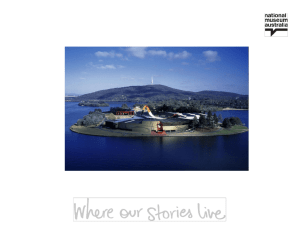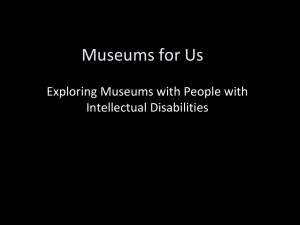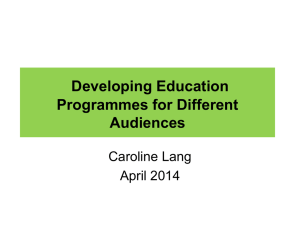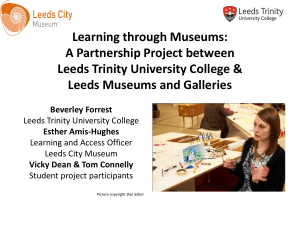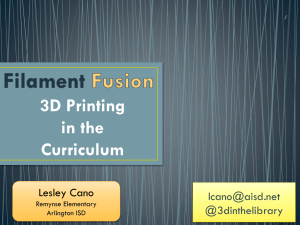Pru Francis Report - Tasmanian Museums Australia Events Blog
advertisement
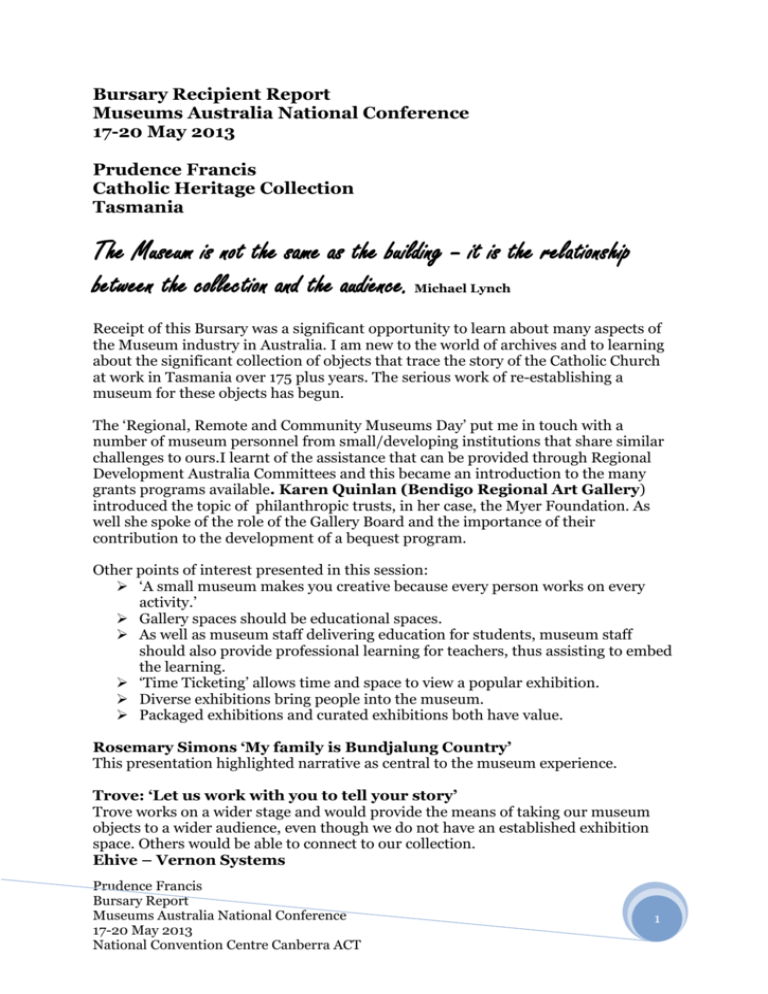
Bursary Recipient Report Museums Australia National Conference 17-20 May 2013 Prudence Francis Catholic Heritage Collection Tasmania The Museum is not the same as the building – it is the relationship between the collection and the audience. Michael Lynch Receipt of this Bursary was a significant opportunity to learn about many aspects of the Museum industry in Australia. I am new to the world of archives and to learning about the significant collection of objects that trace the story of the Catholic Church at work in Tasmania over 175 plus years. The serious work of re-establishing a museum for these objects has begun. The ‘Regional, Remote and Community Museums Day’ put me in touch with a number of museum personnel from small/developing institutions that share similar challenges to ours.I learnt of the assistance that can be provided through Regional Development Australia Committees and this became an introduction to the many grants programs available. Karen Quinlan (Bendigo Regional Art Gallery) introduced the topic of philanthropic trusts, in her case, the Myer Foundation. As well she spoke of the role of the Gallery Board and the importance of their contribution to the development of a bequest program. Other points of interest presented in this session: ‘A small museum makes you creative because every person works on every activity.’ Gallery spaces should be educational spaces. As well as museum staff delivering education for students, museum staff should also provide professional learning for teachers, thus assisting to embed the learning. ‘Time Ticketing’ allows time and space to view a popular exhibition. Diverse exhibitions bring people into the museum. Packaged exhibitions and curated exhibitions both have value. Rosemary Simons ‘My family is Bundjalung Country’ This presentation highlighted narrative as central to the museum experience. Trove: ‘Let us work with you to tell your story’ Trove works on a wider stage and would provide the means of taking our museum objects to a wider audience, even though we do not have an established exhibition space. Others would be able to connect to our collection. Ehive – Vernon Systems Prudence Francis Bursary Report Museums Australia National Conference 17-20 May 2013 National Convention Centre Canberra ACT 1 This session was particularly valuable as we search for a database system that will accommodate both the archive and museum collections. Friday 17 May – Afternoon session: Concurrent Papers All the papers presented provided rich information on how to engage students in a museum experience. Key points raised in the sessions: Engage teachers in professional learning. Create opportunities for students to do their own research. (i.e. The History in Place Project) Use micro narratives (Edward Washington) Take the museum to the students. (The Travelling Chinese Museum) Workshop: Only a fraction of the answer: Approaches for working with communities when resources are limited. Rachael Wilsher-Saa This was an excellent ‘hands-on’ session. Really useful ideas gleaned from the session included: Long term/permanent exhibitions need to be reviewed and changed too. Repeat visitation to the museum is a key indicator of success. Museums need to have a community development approach – go out to the community to promote your organisation. (Schools, aged care facilities, U3A, School for Seniors) Develop a virtual tour of the museum to allow access to museum objects. This is particularly valuable for the aged and others not able to come to a museum. Create a public artists space allowing artists to create and display their work. This work could be a response to something within the collection. “Super Saturday” was a feast of inspiration and ideas. Robyn Archer We love the object, but we need the story. This means having fewer objects on display. Be confident to be minimal. Focus on small groups to tell the big story. It is important that we start collecting the spoken word. There is no substitute for a good idea. Dr Tom Calmo AO Museums are keeping places. Youth have to be part of the culture. It is important to collaborate with many partners e.g. Aboriginal Art Museum, Utrecht, Netherlands.500 works on display and 23,000 visitors per year. Michael Lynch The museum is first and foremost for the people. Encourage stakeholder engagement through keeping in touch. (e.g. M+Matters) The museum is not the same as the building, it is the relationship between the collection and the audience. Prudence Francis Bursary Report Museums Australia National Conference 17-20 May 2013 National Convention Centre Canberra ACT 2 Exhibit in the local community. It is important to understand the connection between art and politics. It is imperative that there is an understanding between art and the first Australians. Michael Brand Too often we are unprepared to meet those from whom we are seeking support. You need to know your stuff. Stefan Hajkowicz Imagination is more important than knowledge. Leading museums that delight, inspire, connect, enrich. Dr Brendan Nelson Values, beliefs, connectedness are far more important than economic indices. The power is in the story: who they are, what they believe, how they think. Develop a film that can be loaded onto an ipad –a way of showing the collection when applying for funding. Tell individual stories. Great value of travelling exhibitions: “We need to get this stuff out”. Engage philanthropic trusts. Richard Mulvaney “We are custodians – we care for it but we must pass it on.” Sunday 19 May – Concurrent Sessions CS3 Working in Museums Ways in: Internships (mainly unpaid) Volunteering. Having a familiarity with technology Finding a good mentor. CS6 Volunteering in the Cultural Sector Volunteers must be treated in a respectful, professional way. Workplace Health and Safety (understanding of) Working with Children and other Police checks – well understood by volunteers. Dealing with short-term young volunteers (usually Uni students) provides a challenge but the sector still needs to encourage these people. Museums must provide meaningful activities. The “Digivols” at the Australian Museum were responsible for digitizing the entire collection. They were trained to photograph and provide online descriptions. Always match the person to the job. 3 types of volunteers: o Young careerists -wanting to work in museums. o Enthusiasts -keen to work in an area of interest but not necessarily interested in mixing socially. o Active Retirees- Learn something and socialize. More women than men. Volunteering is “serious leisure” Intrapersonal constraints: Health, educational attainment and employment. Interpersonal constraints: language spoken at home Prudence Francis Bursary Report Museums Australia National Conference 17-20 May 2013 National Convention Centre Canberra ACT 3 Structural constraints: Age, employment and location. CS13 Exhibition Lighting and Design Showcases are an architectural feature. Use of low reflective glass is encouraged. Tablet controlled cases (you don’t want buttons next to the display) Demand now for demountable showcases. Disaster planning imperative. Internal products should be steel or aluminium, (honeycomb) stone, corian, acrylic. Wood is a good balancer of humidity. Don’t put the collection at risk with the local air conditioning technician – use a museum professional. Lighting – LED. Many poor products on the market. Good solutions if high quality. Perception and reality. Lighting designers break perceptual constancies of colour, size and shape. Lighting specialists must be cognizant of both viewing requirements and conservation requirements. Never trust the light meter! CS21 Contemporary management framework for collection care. Collection care – Develop + Preserve+Access+Use. All collections need people and plant. 10 agents of deterioration: physical forces; dissociation; criminals; water; fire; light and UV; incorrect relative humidity; incorrect temperature; contaminants; pests. Materials science = conservation. Quality of collection storage. There is some discussion around loosening the environmental parameters because going forward the growth is unable to be sustained. When developing a disaster plan – What are our 100 top treasures? Location and details at hand. Check “Australian Risk Management Plan”. Cs24 New collaborations in collection preservation Australian Standard for Preservation Measurement - Humidity 20 degrees + 2. Relative Humidity 50% + - 5% There is a potential relaxation of environment parameters. Conservators and museum directors are at odds over any change to parameters. History tells a different story. During WW1 British Museum treasures stored in the London Underground. During WW2 same items stored in the slate quarries of Wales. No climate control present at either of the above sites and no damage. 20/50 norm specific to London’s climate. Human comfort is one reason for the 20/50 This is not based on deep knowledge. We don’t know how objects react to climate. NMDC Guidelines – rethinking policy and practice with the aim of minimising energy and use. Prudence Francis Bursary Report Museums Australia National Conference 17-20 May 2013 National Convention Centre Canberra ACT 4 What is the history of where the object has lived? These items have reached a stress level already. Always set your temperature and relative humidity to protect the most fragile items in your collection. In moving forward with permanent collections: o Stage 1 – gather documentation o Stage 2 – data analysis (risk assessment) o Stage 3 – experimentation ( how far you can stress your collection) o Stage 4 – maintenance and monitoring. It’s time to put a stake in the heart of the 20/50. Control must be worked to the local climate. B level of ASHRAE - good place to start. National Library switched off the air con in their remote storage facility. Over 3 years the reductions were significant: electricity 10% gas 10% water 5%. Paper–based collections require less temperature control. Need more passive buildings that do not require air-conditioning. Often the temperature is about staff comfort. Lessons learned: paper collections buffer conditions and improve building thermal mass; even minimal insulation helps maintain conditions; conditions can be better without air conditioning; energy saving (March to May $40,000); large volume of air = slow rate of change; the Smithsonian tolerate an RH range of 40-60%. Ref: ICONCC – PAS 198 CS33 Disaster recovery and business continuity Fire – Flagstaff Hill Maritime Village. Disaster preparedness, including disaster bins for staff/volunteer access. Volunteer appointed to speak to all volunteers. Scene locked off for 10 hours as a crime scene(gave time to plan) Business as usual. Ensure safety of staff. Salvage artefacts before site was cleared. 2011 Queensland Floods Communication plans – don’t rely on technology. Keep updating contingency plans Earthquake – Christchurch NZ First quake Civil Defence took over the gallery because of its independent power source (10 days) Significant quake – Civil Defence took over gallery for 7 months. “When you are in this scale of disaster your neighbours problems become your own” Care of staff and allowing them to attend to their own families and homes first is a priority. The new disaster plan does not assume that any one person can be there on site. Put people in teams. Update contact lists. Include locations of light switches on disaster plans. Different levels of events bring different levels of emotions to deal with. People are unpredictable. Prudence Francis Bursary Report Museums Australia National Conference 17-20 May 2013 National Convention Centre Canberra ACT 5 Every staff person needs an “evacuation pack” (basic necessities if you can’t get home) Business continuity plans – so much relies on technology. “Can’t charge the phone or the laptop.” Your gallery/museum needs to be part of a city plan. Christchurch Gallery now closed for 4½ years. Staff have moved into project mode, digitizing the collection; blogging; 70 projects in and around the city; sculptures in public places; videos playing in deserted houses; large scale framed reproductions hung on building around the city. At a point now where staff redundancies are necessary. Two organizational elements of the Conference that I found really positive: The simplicity of only receiving the Conference program and USB upon registration, rather than the usual plethora of “stuff”. The Blue Cross gift to each speaker and workshop presenter. Prudence Francis Bursary Report Museums Australia National Conference 17-20 May 2013 National Convention Centre Canberra ACT 6


